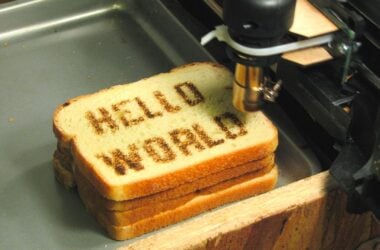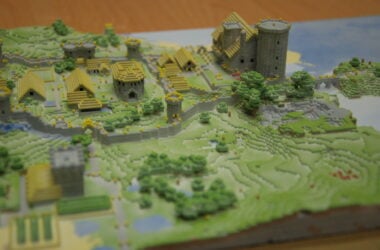In the far away land of Ein Lifon live a unique variety of creatures. The feature that distinguishes these creatures from those of so many other lands is the number of appendages (in this case arms) that they have. Unlike most parts of the world in which most animals have 0, 2, 4, 6, or 8 appendages (with some exceptions for certain insects), in Ein Lifon creatures can have any number of appendages, and frequently do.
This leads to quite a variety of skills and abilities. Unfortunately, when it comes to counting, it also causes confusion. The confusion arises because in Ein Lifon creatures use counting systems based on the number of appendages they have. For example, a three-armed Tridipia only knows three number symbols: 0, 1, 2. Four-armed Quadrupeds know four number symbols 0, 1, 2, 3. As you might suspect, the eight-armed Octovian knows 0, 1, 2, 3, 4, 5, 6, 7 and so on.
The symbols used for counting affect how quantities are written. To better understand this, consider for a moment how we, ten-fingered humans, write numbers. Perhaps because we have ten fingers, we use the decimal system, written with ten unique symbols: 0, 1, 2, 3, 4, 5, 6, 7, 8, 9. In order to record numbers greater than nine, we combine these ten symbols in a specific manner.
For starters, after nine, we use the 1 and the 0 to write the quantity 10. One way to think of 10 is that the 1 represents one entire set of ten fingers, and the 0 tells us we have nothing added to those ten fingers. Of course, after ten comes eleven, which we all know is written as 11. In other words we have 1 entire set of fingers and have 1 left over. We continue on like this until 19, after which point we write 20 – two entire sets of fingers and nothing more. Eventually we get up to 99. At this point we write 100, which can be thought of as 1 entire set of two-digit numbers, 0 additional two-digit numbers, and 0 additional one-digit numbers. In essence, every time we run out of numbers we add an additional digit and start again.
The creatures of Ein Lifon follow this same logic when they write numbers. Take for example three-armed Tridipia. To represent the quantity one, they write the symbol 1. For two they write 2. But after 2, the run out of symbols, just as humans run out of symbols when we reach 9. Like us, they combine the symbols they have and write 10. So for Tridipia 10 represents the same quantity that 3 represents for humans. A Tridipia would continue by writing 11 and 12. Can you guess what she would write after 12? Recall, she is all out of digits (3, 4, 5, … do not exist in her mind).
If you guessed that she would write 20 give yourself a pat on the back. After 12 she records 2 complete sets of appendages and 0 more. The chart below compares how Tridipia count to how humans count:
| Human Counting | 0 | 1 | 2 | 3 | 4 | 5 | 6 | 7 | 8 | 9 | 10 | 11 | 12 | 13 |
| Tridipia Counting | 0 | 1 | 2 | 10 | 11 | 12 | 20 | 21 | 22 | 100 | 101 | 102 | 110 | 111 |
Changing the way a quantity is written based on the number of symbols available is known as changing bases. Humans count in base ten. Tridipia count in base three. You may have heard that computers usually count in base two.
Take a look at the groups of stones below, as counted by various creatures on Ein Lifon. Each is counting the same pile of stones (12 of them as most humans we write using the decimal system). However, each creature has a different number of arms, and is accustomed to grouping the stones in different size piles. Once they are grouped, they use the symbols available to them to record the total number of stones they counted. As you see, even though they count the same number of stones, they each record the total in a different base.
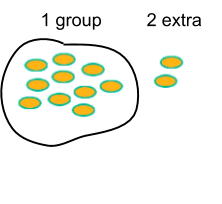
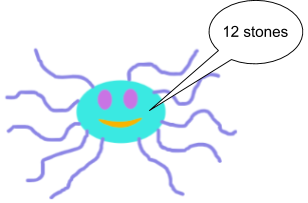
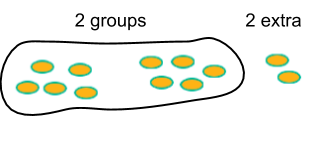

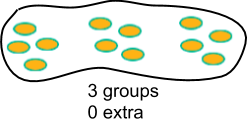
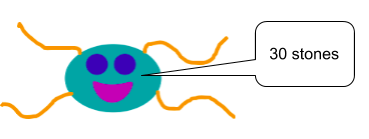

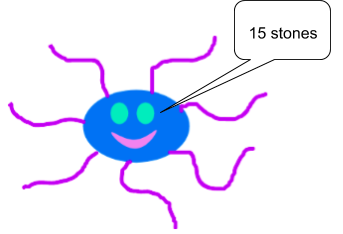
The creatures above used base ten, base four, base five, and base seven. If you would like more practice counting in these bases, try filling in the blanks for each base below.
Base 4
0, 1, 2, 3, 10, 11, _____, 13, 20, 21, _____, 23, _____, 31, 32, 33, 100, _____, 102, 103
Base 5
0, 1, 2, 3, 4, 10, _____, 12, 13, 14, _____, 21, 22, 23, _____, 30, 31, _____, 33, 34, 40
Base 7
0, 1, 2, 3, _____, 5, 6, 10, _____, 12, 13, 14, 15, 16, _____, 21, 22, 23, 24, 25, _____, 30
Solutions
Base 4
0, 1, 2, 3, 10, 11, 12, 13, 20, 21, 22, 23, 30, 31, 32, 33, 100, 101, 102, 103
Base 5
0, 1, 2, 3, 4, 10, 11, 12, 13, 14, 20, 21, 22, 23, 24, 30, 31, 32, 33, 34, 40
Base 7
0, 1, 2, 3, 4, 5, 6, 10, 11, 12, 13, 14, 15, 16, 20, 21, 22, 23, 24, 25, 26, 30
Learn More
Numbers and Bases
https://betterexplained.com/articles/numbers-and-bases/
Ancient number systems
https://www.mentalfloss.com/article/31879/12-mind-blowing-number-systems-other-languages
Wikipedia
https://simple.wikipedia.org/wiki/Base_(mathematics)
Binary
https://www.purplemath.com/modules/numbbase.htm
number bases
https://www.mathsisfun.com/numbers/bases.html
number bases and binary numbers
https://www.purplemath.com/modules/numbbase.htm
Learn about number bases
Base-10 system
http://www.amathsdictionaryforkids.com/qr/b/base10system.html









